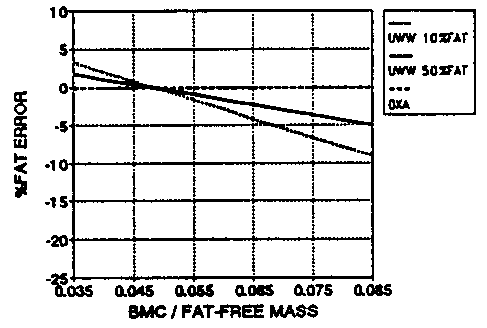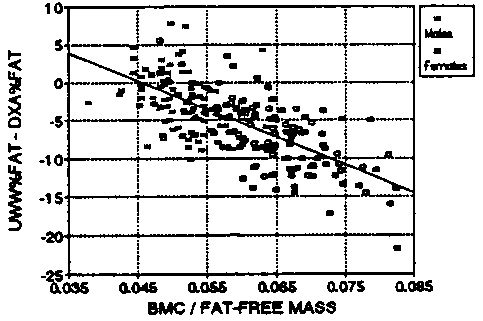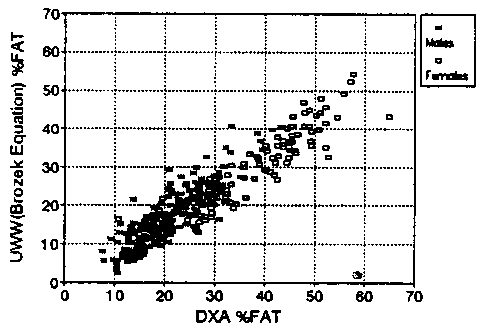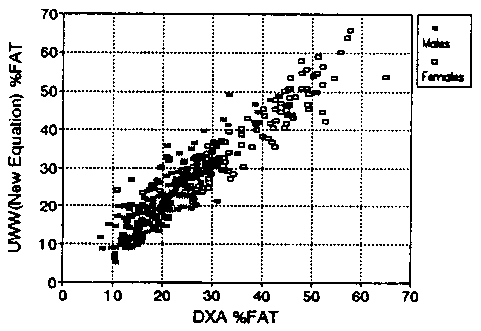1000
Asia Pacific J Clin Nutr (1995) 4: 177-179
Asia Pacific J Clin Nutr (1995) 4: 177-179

A new equation set for converting
body density to percent body fat
R. H. Nord and R. K. Payne
Norland Corporation, Fort Atkinson,
Wisconsin, USA.
One source of error in the underwater weighing (UWW)
method of body fat determination is variability in bone mass as
a fraction of total nonfat mass. We examined this error theoretically
and experimentally using data gathered on 219 human subjects who
were measured by UWW and also by the newer technique of dualenergy
X-ray absorptiometry (DXA). The experimental data suggest an error
was made in the assumed bone mass fraction used in the derivation
of the Brozek equation, the standard means of converting the body
density values obtained in UWW to body fat percent. Using this new
experimental data, a new equation (set) is proposed for use in UWW
measurements.
Introduction
Underwater Weighing (UWW) has been an accepted method
of determining the fat content of the human body for many years. Dual-energy
X-ray absorptiometry (DXA) is a relatively new method for determining
the bone mineral content and also the fat content of the body. One
of the weaknesses of UWW is its sensitivity to variability of bone
mass as a fraction of the lean compartment in different individuals.
Since DXA differentiates bone mineral and measures it independently,
it is possible to use DXA data to investigate the error in UWW. In
doing so we found two ways in which the UWW method could be improved.
We developed a new equation set for calculation of body fat percent
from body density which (a) takes into account a difference in bone
mass fraction between the sexes, and (b) corrects an error in the
average value for bone mass fraction which was used in the derivation
of the widely used Brozek equation.
Theoretical
sensitivity of UWW to bone mass
The standard equations used in UWW assume that bone
mineral, which has a relatively high density, will be a fixed fraction
of the lean compartment. Any deviation from this fraction in an individual
will result in an error in calculated percent fat. Figure I shows
this error computed theoretically for typical subjects using the tissue
densities and the bone mineral fraction of 4.8% given by Brozek1.
Note that 0.048 is the value at which the %FAT error is zero. Since
DXA is able to measure bone mineral mass independently, there is no
similar error in DXA.
Figure 1. Theoretical error in percent fat
as a function of bone mass fraction of total nonfat mass (typical
subject 55 kg).

Figure 2. Experimental difference between UWW
and DXA percent fat measurements as a function of bone mass fraction
as measured by DXA. Mean values for BMC/FFM are 0.052 for men and
0.065 for women. Data from St Luke's Hospital2 and the
Un 1000 iversity of Wisconsin3.

Experimental
results
In the process of calibrating Norland's DXA body composition
software, both DXA and UWW measurements were made on 219 volunteer
subjects. The measurements were made at two sites, the Body Composition
Unit at St Luke's Hospital in New York City2, and the Department
of Sports Medicine at the University of Wisconsin in Madison3.
The DXA measurement provides a measure of the confounding
factor (bone mass) and also a measure of body fat percent which is
expected to be free of this error. The parameter which is related
to the error is the ratio of bone mineral mass (BMC) total fat-free
mass (FFM). The difference between percent fat by UWW and by DXA is
plotted versus the ratio BMC FFM in Fig.2. Compare this plot with
the theoretical plot of Fig. l .
The experimental data follow approximately the theoretical
linear distribution, and the regression line crosses the zero error
axis at 0.044, which is close to value of 0.048 used in the development
of the Brozek equation. The fact that the slope of the regression
line is greater than expected may be an indication of yet another
dependency on bone mass in one of the techniques, although at present
we do not know what it is.
What is clear from the data is that the mean value
of BMC FFM for this population is not 4.8% as given by Brozek, and
that there is a significant difference in this parameter for men and
women. The mean values we obtained are 5.2% for men, and 6.5% for
women.
An improved
underwater weighing equation
Figure 3 compares the percent fat (%FAT) values from
UWW with those of DXA on 219 human subjects. The standard Brozek equation
was used in the UWW calculations. Note that the agreement is not very
good, with a regression slope of 0.84.
Figure 3. Percent body fat by UWW and by DXA
compared; standard Brozek equation used to calculate UWW result. Regression:
UWW%FAT = 0.843 * DXA%FAT - 1.14. Data from St Luke's Hospital2
and the University of Wisconsin3.

In a previous paper4, from examination
of the same experimental data, we suggested that there may be a systematic
error in the Brozek equation and that this may be the source of the
disagreement between the two methods.
We therefore decided to develop a new version of the
Brozek equation (actually a set of two because of the sex difference).
In addition to using different values for BMC/FFM as set out above,
we used a slightly different value of the density of lean soft tissue,
which we calculated from published body data, as follows:
Woodard and White5 give typical values
of the composition of 36 tissue groups or organs, as percent water,
lipid, protein, ash, and other materials such as carbohydrates. White,
Woodard, and Hammond6 give the masses of nearly the same
list of tissue groups and organs for a typical male and female. We
combined these data to give the total masses of the water, protein
plus carbohydrates, and ash in non-skeletal parts of the typical male
and female bodies. The resulting mass fractions were used, with densities
for the component materials given by Brozek1, to obtain
a combined density for the lean soft tissue compartment. Our value
for lean tissue density is 1.0736, compared with Brozek's value of
1.0694.
Derivation
f19 of the new equations
Derivation of the new equations consists of combining
densities according to the rule

where Dtotal is the combined density of
a combination of materials having densities Dl, D2, D3, . . ., according
to the proportion given by mass fractions fl, f2, f3, ....
We used the following parameters:
Dbone = 2.98 (Brozek)
Dfat (lipid) = 0.915 (Brozek)
Dlean (non-bone) = 1.0736 (prev. section)
BMC FFM (Men) = 0.0523 (Figure 2)
BMC/FFM (Women) = 0.0647 (Figure 2)
We first obtain values for the value for the total
non-fat density:
 Dnonfat (Men) = 1.10914
Dnonfat (Men) = 1.10914
Dnonfat (Women) = 1.11833
Then,

Solving for f, the body fat fraction, and multiplying
by 100 for fat percent, gives:

Conclusion
Figure 4 shows the improvement in agreement between
UWW and DXA when the new equations are used. Note that the slope of
the regression using the new equations is 1.02 compared with 0.84
using the Brozek equation.
Figure 4. Percent body fat by UWW and by DXA
compared; new equation set used to calculate UWW result. Regression
UWW%FAT = 1.020 * DXA%FAT + 0.68 Data from St Luke's Hospital2
and the University of Wisconsin3.

Reference
- Brozek J, et al. Densitometric analysis of body
composition: revision of some quantative assumptions. Ann NY Acad
Sci 1963; 110:112-140.
- Pierson RM, et al. Body Composition Unit, St Luke's
Hospital, New York. Private communication.
- Clark RR, et al. Sports Medicine Centre, Univ of
Wisconsin, Madison. Private communication.
- Nord RH, Payne RK. Body composition by DXA—a
review of the technology. Asia Pacific J Clin Nutr 1994;3.
- Woodard HQ, White DR. The composition of body tissues.
Br J Radiology 1986; 59:1209- 1219.
- White DR, Woodard HQ, Hammond SM. Average soft-tissue
and bone models for use in radiation dosimetry. Br J Radiology 1987;
60:907-913.

Copyright © 1996 [Asia Pacific Journal of Clinical
Nutrition]. All rights reserved.
Revised:
January 19, 1999
.
 to the top
to the top
0